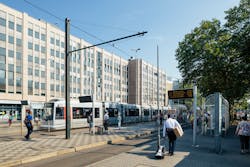This article originally appeared in the August 2023 issue of Security Business magazine. When sharing, don’t forget to mention Security Business magazine on LinkedIn and @SecBusinessMag on Twitter.
Most transit agencies still rely on siloed, proprietary systems for daily operations; however, due to rapid digital transformation, increasing urbanization, and growing expectations from commuters and governments, transit organizations are beginning to modernize. They are exploring ways to enable closer collaboration to enhance security and improve the rider experience.
Systems integrators can play a significant role in helping mass transit organizations identify opportunities to break down silos and get more out of their security system.
A unified system brings data from all devices and systems into one software platform, so mass transit teams can see everything in one place instead of switching between multiple different systems to view and analyze data. Modern unified systems enable transit organizations to bring various data sources together within a single interface to help improve collaboration, enable data sharing among stakeholders, optimize daily tasks, reduce cybersecurity risks, and more.
Begin the Discussion with ‘the why’
With so many opportunities, it can feel overwhelming for customers to try to filter out the noise and figure out where to start. An integrator’s team can help them think through their goals and objectives to find the best solutions for their needs.
Start by identifying what questions the customer is trying to answer or the problem they are trying to solve. Do they need to know bus demand in real time? Do they want to be alerted when objects are left behind on a bus or train? Do they need to count the number of people at a train station to manage routes efficiently?
After they have defined the questions, help them identify systems they may have that provide actionable data, or introduce them to potential new solutions. Bringing data from these systems into a single interface can help them answer these questions more efficiently.
How to Overcome Departmental Silos
Silos can be a significant obstacle in the mass transit industry. One group may manage buses, and another manages subways or light-railAs a result, transit organizations may be paying for systems and other technology that duplicate efforts. For example, onboard systems that do not communicate with wayside infrastructure systems are often a source of redundant technology.
Making the switch to a unified system benefits more than just one team. The power of a unified system is its ability to bring together disparate systems and present data intuitively to various departments.
A good starting point is to get everyone in the same room. Talk about challenges and explore how to structure a solution that can benefit everyone. When the customer has a clear understanding of their obstacles and goals, it will give the integrator a better idea of what technologies can best support them.
A unified system even allows different departments to set up unique dashboards with information specific to their goals. Security teams, marketing departments, and facilities teams can have a common language for their systems but interact with dashboards that are relevant to their needs.
The more data that a mass transit customer can share and gather, the better view they have of how people move from here to there. You want everyone at the table to be motivated to progress in the same direction.
Improving the Passenger Experience
One of the main goals of many mass transit organizations is to improve the passenger experience. For commuters, knowing whether a bus or train is late or which train car is least crowded can make a huge difference in their day. They want to be able to quickly check when the next bus is arriving or pre-pay their parking fees online. Some may even seek to reserve a parking spot for the following day.
When onboard systems are connected to wayside systems, transit agencies can more easily optimize how to deploy fleets and improve the commuter experience. This could include a reduction of bottlenecks at bus stations, pay-by-plate parking, or other ways of streamlining operations.
Transit authorities are also beginning to explore how the power of data from video analytics, LiDAR, and other systems. Some are even experimenting with predictive analytics so they can reroute buses to respond to anticipated spikes in demand. This type of use case is still in the early stages but will become more advanced soon.
Digital Evidence Sharing
A unified system can also improve passengers’ and drivers’ sense of personal safety. Staff and passengers feel more secure knowing that security will respond quickly and effectively if there is an incident on board a bus or near a station.
If there is an incident that needs to be investigated, a unified system with a digital evidence management system (DEMS) can help speed up the investigation. These systems allow mass transit security teams to share evidence efficiently and securely with local first responders.
When cameras capture driving infractions, possible threats, or other suspicious activity, a DEMS makes it easy to tag and share encrypted, watermarked video with authorities. The software can even blur faces to protect the privacy of bystanders.
It is as easy as sending an email, and the system ensures all best practices are followed and maintains evidence’s chain of custody. It also helps ensure security when sharing sensitive information among internal departments and outside stakeholders.
Being able to log in once and access information from video surveillance, automatic license plate recognition (ALPR), and other sensors has made sharing data easier than using siloed systems.
Helping Mass Transit Customers Make the Switch
The first step to help customers transition to a unified system is to identify any closed systems they may have. Recommend replacing them with solutions that run on open-architecture platforms. Then begin reviewing the systems that they have in place that could provide valuable insight and improve operations if unified with other systems.
As part of the initial review, consider suggesting other like-minded municipal agencies that could be part of the conversation. Transit agencies are not unique in what they are searching for. Other customers may be wrestling with similar challenges and can provide a point of reference for your customer. For example, law enforcement agencies often need to find solutions for doing more with less and can use data gathered through the transit infrastructure. Many departments have been successful in leveraging technology to do this. What can be learned from their successes?
Likewise, consider whether there are any agencies or departments with whom your customer could partner to share systems or data. Urban planning departments, for example, could benefit greatly from having more in-depth knowledge of how people move within a city. Or perhaps the local department of transportation would consider partnering to reduce congestion.
By getting their input and buy-in early on, your customer and their community partners could see a higher return on their investment.
Take it Step by Step
Once goals and stakeholders are identified, you can start by helping your customer bring data from open systems into a unified platform. Start by identifying your customer’s biggest pain points, then fix them one at a time. Trying to do too much becomes a massive undertaking that may seem daunting for your customer. Like any journey, take it one step at a time.
For example, if they have three similar systems running, could you move towards harmonizing them into one shared system? Some common hardware, like cameras, access control sensors, or door controls, may work perfectly well within a new unified system.
Look for the quick wins too. You may be able to leverage some technology they already have. For example, perhaps they have sensors in their subway tunnels to detect the presence of people or animals. Data from those sensors could be useful for security, operations, maintenance teams, and even law enforcement.
Future Scalability
Exciting innovations are happening in technology that help transit authorities improve rider and employee safety, operational efficiency, and customer experience. Internet-connected sensors are being added to monitor air quality, keep track of battery levels on electric vehicles, and even monitor driving behavior to ensure safety.
A unified, open physical security platform helps transit organizations tap into the full potential of solutions they already own and adopt new ones as they are available. Teams across the organization can come together on a common toolset to gain insights and make improvements to the processes they do every day.
As new possibilities are available in the future, a unified, open architecture system allows your mass transit customers to adopt best-of-breed technology and evolve with their changing needs.
About the Author

Augusto Chiaravalloti
Augusto Chiaravalloti is Industry Marketing Manager for Public Sector, Justice & Public Safety at Genetec Inc. Request more info about the company at www.securityinfowatch.com/10213771.


